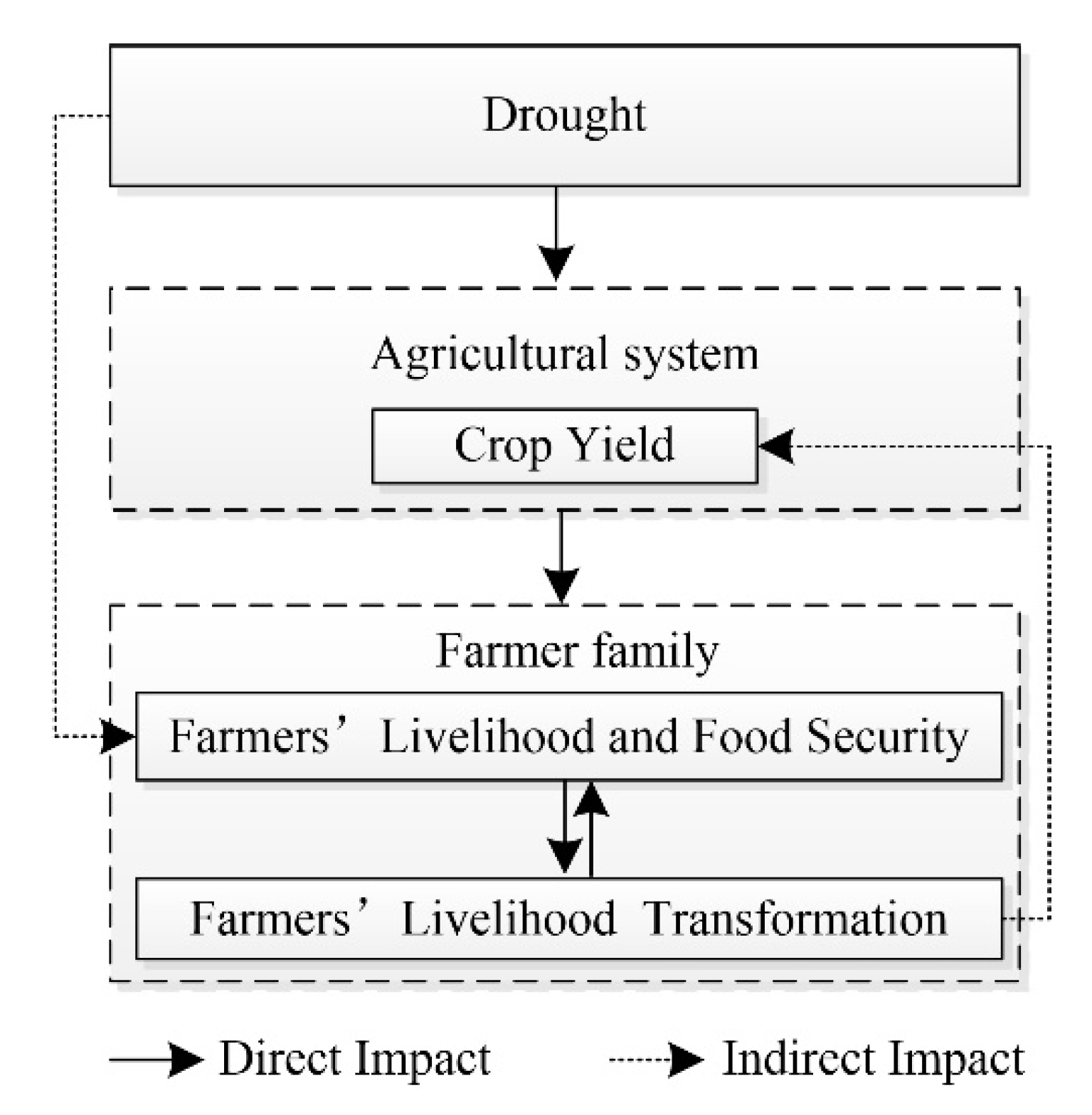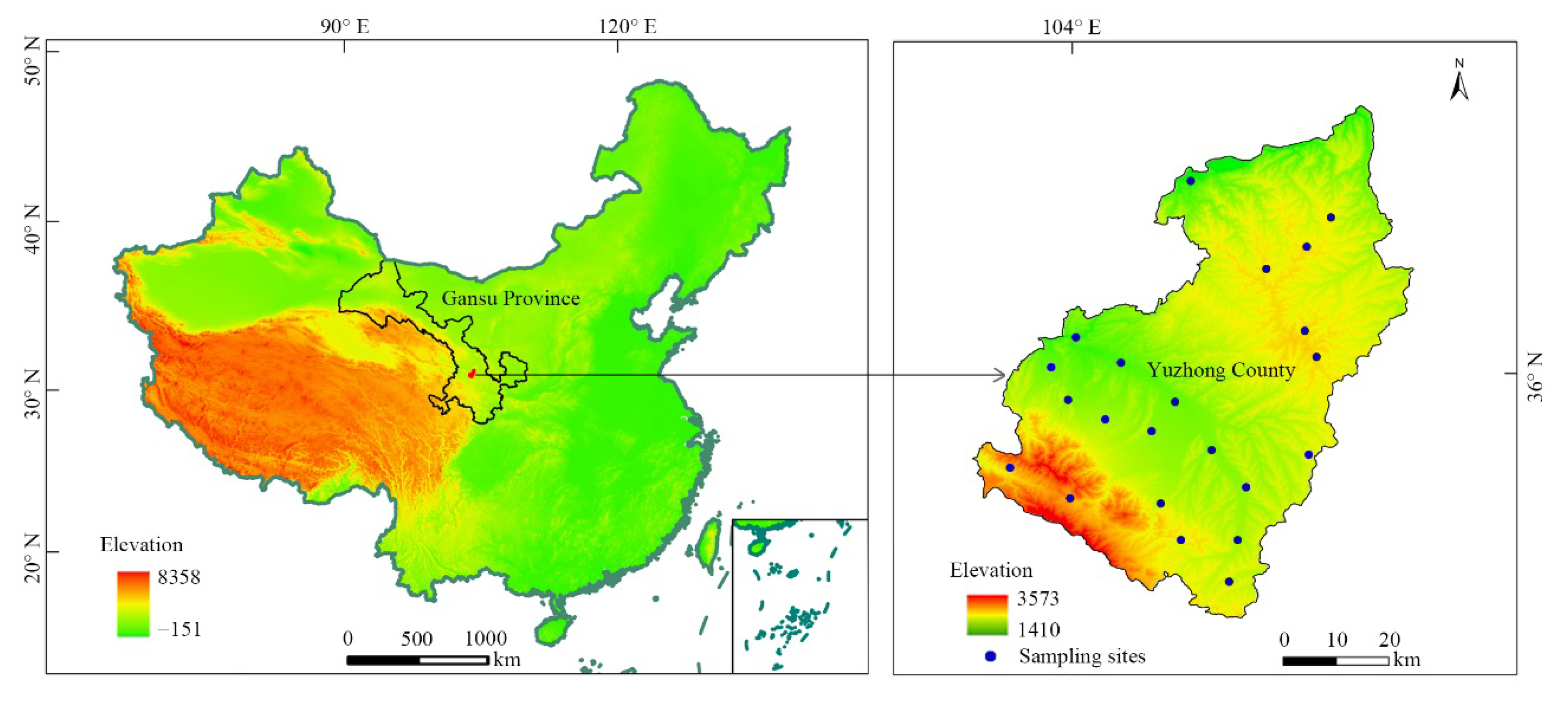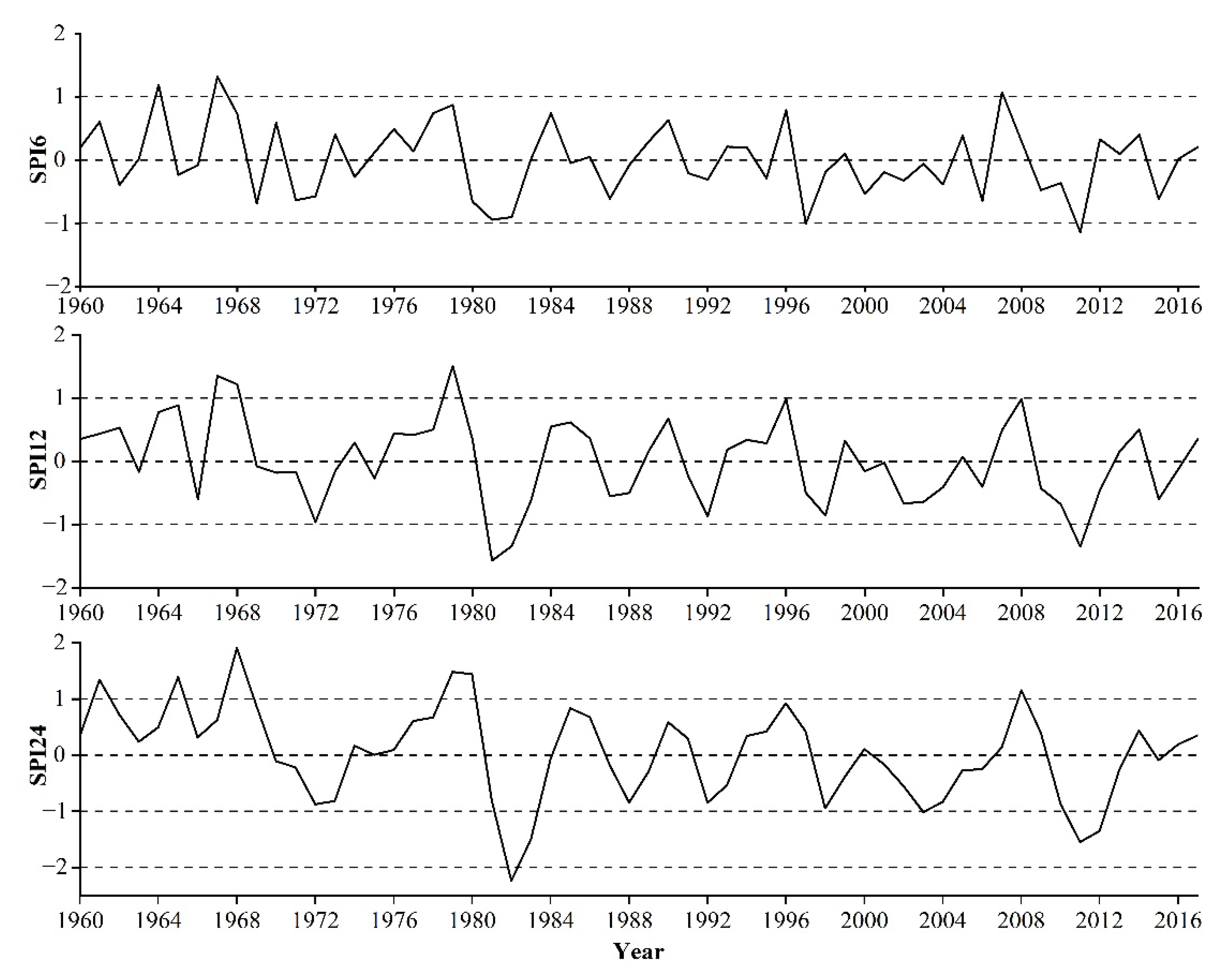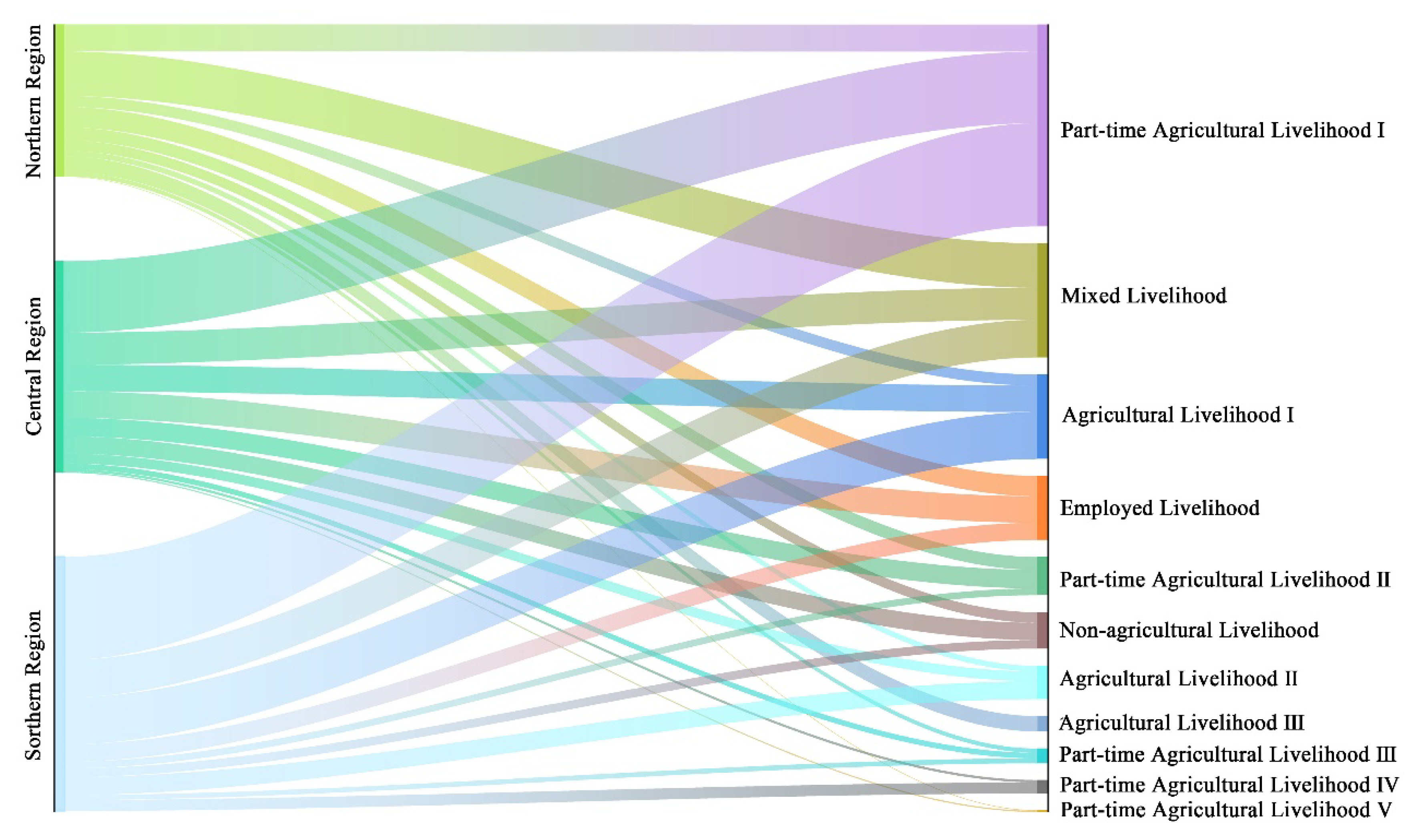The Integrated Impact of Drought on Crop Yield and Farmers’ Livelihood in Semi-Arid Rural Areas in China
Abstract
1. Introduction
2. Analytical Framework to Assess the Integrated Impact of Drought
3. Materials and Methods
3.1. Study Area
3.2. Data Collection and Sampling
3.3. Methods
3.3.1. SPI
3.3.2. Correlation Analysis
3.3.3. Two-Step Cluster Analysis
4. Results
4.1. Time Variability of Drought Characterization
4.2. Correlation Analysis between Drought and Crop Yield
4.3. Drought Impact on Different Types of Farmer Families
4.3.1. Classification of Farmer Type
4.3.2. Impact of Drought on Economic Loss and Farmer Livelihood
4.3.3. Impact of Drought on Farmer Food Security
4.3.4. Farmer Livelihood Transformations and Trajectories
5. Conclusions, Discussion, and Policy Implications
Author Contributions
Funding
Institutional Review Board Statement
Informed Consent Statement
Data Availability Statement
Acknowledgments
Conflicts of Interest
References
- Lopez-Nicolas, A.; Pulido-Velazquez, M.; Macian-Sorribes, H. Economic risk assessment of drought impacts on irrigated agriculture. J. Hydrol. 2017, 550, 580–589. [Google Scholar] [CrossRef]
- Cao, S.P.; He, Y.; Zhang, L.F.; Chen, Y.; Yang, W.; Yao, S.; Sun, Q. Spatiotemporal characteristics of drought and its impact on vegetation in the vegetation region of Northwest China. Ecol. Indic. 2021, 133, 108420. [Google Scholar] [CrossRef]
- Satoh, Y.; Yoshimura, K.; Pokhrel, Y.; Kim, H.; Shiogama, H.; Yokohata, T.; Hanasaki, N.; Wada, Y.; Burek, P.; Byers, E.; et al. The timing of unprecedented hydrological drought under climate change. Nat. Commun. 2022, 13, 3287. [Google Scholar] [CrossRef]
- Madadgar, S.; AghaKouchak, A.; Farahmand, A.; Davis, S.J. Probabilistic estimates of drought impacts on agricultural production. Geophys. Res. Lett. 2017, 44, 7799–7807. [Google Scholar] [CrossRef]
- Sharafi, L.; Zarafshani, K.; Keshavarz, M.; Azadi, H.; Passel, S. Farmers’ decision to use drought early warning system in developing countries. Sci. Total Environ. 2021, 758, 142761. [Google Scholar] [CrossRef]
- Deb, P.; Moradkhani, H.; Han, X.; Abbaszadeh, P.; Xu, L. Assessing irrigation mitigating drought impacts on crop yields with an integrated modeling framework. J. Hydrol. 2022, 609, 127760. [Google Scholar] [CrossRef]
- Prodhan, F.A.; Zhang, J.H.; Sharma, T.P.P.; Nanzad, L.; Zhang, D.; Seka, A.M.; Ahmed, N.; Hasan, S.S.; Hoque, M.Z.; Mohana, H.P. Projection of future drought and its impact on simulated crop yield over South Asia using ensemble machine learning approach. Sci. Total Environ. 2022, 807, 151029. [Google Scholar] [CrossRef]
- Zhang, Q.; Shi, R.; Singh, V.P.; Wang, J.A.; Liang, Q.O. Droughts across China: Drought factors, prediction and impacts. Sci. Total Environ. 2022, 803, 150018. [Google Scholar] [CrossRef]
- Su, B.D.; Huang, J.L.; Fischer, T.; Wang, Y.J.; Kundzewicz, Z.W.; Zhai, J.Q.; Sun, H.M.; Wang, A.Q.; Zeng, X.F.; Wang, G.J.; et al. Drought losses in China might double between the 1.5 °C and 2.0 °C warming. Proc. Natl. Acad. Sci. USA 2018, 115, 10600–10605. [Google Scholar] [CrossRef]
- Smith, L.C.; Frankenberger, T.R. Recovering from severe drought in the drylands of Ethiopia: Impact of Comprehensive Resilience Programming. World Dev. 2022, 156, 105829. [Google Scholar] [CrossRef]
- Solano-Hernández, A.; Bruzzone, O.; Groot, J.; Laborda, L.; Martínez, A.; Tittonell, P.; Easdale, M.H. Convergence between satellite information and farmers’ perception of drought in rangelands of North-West Patagonia, Argentina. Land Use Policy 2020, 97, 104726. [Google Scholar] [CrossRef]
- Keshavarz, M.; Maleksaeidi, H.; Karami, E. Livelihood vulnerability to drought: A case of rural Iran. Int. J. Disast. Risk. Reduct. 2017, 21, 223–230. [Google Scholar] [CrossRef]
- Nasrnia, F.; Ashktorab, N. Sustainable livelihood framework-based assessment of drought resilience patterns of farmers of Bakhtegan basin, Iran. Ecol. Indic. 2021, 128, 107817. [Google Scholar] [CrossRef]
- Ahmad, M.M.; Yaseen, M.; Saqib, S.E. Climate change impacts of drought on the livelihood of dryland smallholders: Implications of adaptation challenges. Int. J. Disast. Risk. Reduct. 2022, 80, 103210. [Google Scholar] [CrossRef]
- Mohammed, S.; Alsafadi, K.; Enaruvbe, G.O.; Bashir, B.; Elbeltagi, A.; Széles, A.; Alsalman, A.; Harsanyi, E. Assessing the impacts of agricultural drought (SPI/SPEI) on maize and wheat yields across Hungary. Sci. Rep. 2022, 12, 8838. [Google Scholar] [CrossRef]
- Abhishek, A.; Das, N.N.; Ines, A.V.M.; Andreadis, K.M.; Jayasinghe, S.; Granger, S.; Ellenburg, W.L.; Dutta, R.; Quyen, N.H.; Markert, A.M.; et al. Evaluating the impacts of drought on rice productivity over Cambodia in the Lower Mekong Basin. J. Hydrol. 2021, 599, 126291. [Google Scholar] [CrossRef]
- Vicente-Serrano, S.M.; Peña-Angulo, D.; Murphy, C.; López-Moreno, J.I.; Tomas-Burguera, M.; Domínguez-Castro, F.; Tian, F.; Eklundh, L.; Cai, Z.; Alvarez-Farizo, B.; et al. The complex multi-sectoral impacts of drought: Evidence from a mountainous basin in the Central Spanish Pyrenees. Sci. Total Environ. 2021, 769, 144702. [Google Scholar] [CrossRef]
- Leng, G.; Hall, J. Crop yield sensitivity of global major agricultural countries to droughts and the projected changes in the future. Sci. Total Environ. 2019, 654, 811–821. [Google Scholar] [CrossRef]
- Daryanto, S.; Wang, L.; Jacinthe, P.A. Global synthesis of drought effects on cereal, legume, tuber and root crops production: A review. Agric. Water Manag. 2017, 179, 18–33. [Google Scholar] [CrossRef]
- Li, Y.; Guan, K.; Schnitkey, G.D.; DeLucia, E.; Peng, B. Excessive rainfall leads to maize yield loss of a comparable magnitude to extreme drought in the United States. Glob. Change Biol. 2019, 25, 2325–2337. [Google Scholar] [CrossRef]
- Hamal, K.; Sharma, S.; Khadka, N.; Haile, G.G.; Joshi, B.B.; Xu, T.L.; Dawadi, B. Assessment of drought impacts on crop yields across Nepal during 1987–2017. Meteorol. Appl. 2020, 27, e1950. [Google Scholar] [CrossRef]
- Wang, Q.; Liu, Y.Y.; Zhang, Y.Z.; Tong, L.J.; Li, X.Y.; Li, J.L.; Sun, Z.G. Assessment of spatial agglomeration of agricultural drought disaster in China from 1978 to 2016. Sci. Rep. 2019, 9, 14393. [Google Scholar] [CrossRef]
- Kamali, B.; Jahanbakhshi, F.; Dogaru, D.; Dietric, J.; Nendel, C.; AghaKouchak, A. Probabilistic modeling of crop-yield loss risk under drought: A spatial showcase for sub-Saharan Africa. Environ. Res. Lett. 2022, 17, 024028. [Google Scholar] [CrossRef]
- Zhu, X.; Liu, T.; Xu, K.; Chen, C.X. The impact of high temperature and drought stress on the yield of major staple crops in northern China. J. Environ. Manag. 2022, 314, 115092. [Google Scholar] [CrossRef]
- Labudová, L.; Labuda, M.; Takáč, J. Comparison of SPI and SPEI applicability for drought impact assessment on crop pro-duction in the Danubian Lowland and the East Slovakian Lowland. Theor. Appl. Climatol. 2017, 128, 491–506. [Google Scholar] [CrossRef]
- Li, E.; Zhao, J.; Pullens, J.W.M.; Yang, X.G. The compound effects of drought and high temperature stresses will be the main constraints on maize yield in Northeast China. Sci. Total Environ. 2022, 812, 152461. [Google Scholar] [CrossRef]
- Wang, Y.; Zhao, W.; Zhang, Q.; Yao, Y.B. Characteristics of drought vulnerability for maize in the eastern part of Northwest China. Sci. Rep. 2019, 9, 964. [Google Scholar] [CrossRef]
- Zhou, Z.; Shi, H.; Fu, Q.; Li, T.X.; Gan, T.Y.; Liu, S.N. Assessing spatiotemporal characteristics of drought and its effects on climate-induced yield of maize in Northeast China. J. Hydrol. 2020, 588, 125097. [Google Scholar] [CrossRef]
- Thao, N.T.T.; Khoi, D.N.; Xuan, T.T.; Tychon, B. Assessment of livelihood vulnerability to drought: A case study in Dak Nong Province, Vietnam. Int. J. Disast. Risk. Sci. 2019, 10, 604–615. [Google Scholar] [CrossRef]
- He, X.G.; Estes, L.; Konar, M.; Tian, D.; Anghileri, D.; Baylis, K.; PEvans, T.; Sheffield, J. Integrated approaches to understanding and reducing drought impact on food security across scales. Curr. Opin. Env. Sust. 2019, 40, 43–54. [Google Scholar] [CrossRef]
- Guan, X.J.; Zang, Y.W.; Meng, Y.; Liu, Y.; Lv, H.; Yan, D.H. Study on spatiotemporal distribution characteristics of flood and drought disaster impacts on agriculture in China. Int. J. Disast. Risk. Reduct. 2021, 64, 102504. [Google Scholar] [CrossRef]
- Shahbazbegian, M.; Bagheri, A. Rethinking assessment of drought impacts: A systemic approach towards sustainability. Sustain. Sci. 2010, 5, 223–236. [Google Scholar] [CrossRef]
- Khayyati, M.; Aazami, M. Drought impact assessment on rural livelihood systems in Iran. Ecol. Indic. 2016, 69, 850–858. [Google Scholar] [CrossRef]
- Sadiqi, S.S.J.; Hong, E.M.; Nam, W.H.; Kim, T. Review: An integrated framework for understanding ecological drought and drought resistance. Sci. Total Environ. 2022, 846, 157477. [Google Scholar] [CrossRef]
- Wang, J.; Yang, X.J.; Liu, W.Z. The quantitative research on the resilience of social-ecological system to drought in the semi-arid area. Prog. Geogr. 2010, 29, 1385–1390. [Google Scholar]
- Liu, L.C.; Liu, C.F.; Wang, C.; Li, P.J. Supply and demand matching of ecosystem services in loess hilly region: A case study of Lanzhou. Acta. Geogr. Sin. 2019, 74, 1921–1937. [Google Scholar]
- Zhao, X.Y.; Ma, P.Y.; Li, W.Q.; Du, Y.X. Spatiotemporal changes of supply and demand relationships of ecosystem services in the Loess Plateau. Acta. Geogr. Sin. 2021, 76, 2780–2796. [Google Scholar]
- Zhang, Y.; Liu, X.H.; Jiao, W.Z.; Zhao, L.J.; Zeng, X.M.; Xing, X.Y.; Zhang, L.N.; Hong, Y.X.; Lu, Q.Q. A new multi-variable integrated framework for identifying flash drought in the Loess Plateau and Qinling Mountains regions of China. Agr. Water Manag. 2022, 265, 107544. [Google Scholar] [CrossRef]
- Shi, Y.Z.; Yang, X.J.; Zhao, X.Y. Impacts of meteorological drought on social-ecological system in rural areas of Yuzhong county in Gansu province. J. Nat. Resour. 2019, 34, 1987–2000. [Google Scholar]
- Li, Q.Q.; Cao, Y.P.; Miao, S.L.; Huang, X.H. Spatiotemporal characteristics of drought and wet events and their impacts on agriculture in the Yellow River Basin. Land 2022, 11, 556. [Google Scholar] [CrossRef]
- Mahmoudi, P.; Ghaemi, A.; Rigi, A.; Jahanshahi, S.M.A. Recommendations for modifying the Standardized Precipitation Index (SPI) for drought monitoring in arid and semi-arid regions. Water Resour. Manag. 2021, 35, 3253–3275. [Google Scholar] [CrossRef]
- Liu, C.H.; Yang, C.P.; Yang, Q.; Wang, J. Spatiotemporal drought analysis by the standardized precipitation index (SPI) and standardized precipitation evapotranspiration index (SPEI) in Sichuan Province, China. Sci. Rep. 2021, 11, 1280. [Google Scholar] [CrossRef]
- Liu, X.F.; Pan, Y.Z.; Zhu, X.F.; Yang, T.T.; Bai, J.J.; Sun, Z.L. Drought evolution and its impact on the crop yield in the North China Plain. J. Hydrol. 2018, 564, 984–996. [Google Scholar] [CrossRef]
- Qin, H.T.; Huang, Q.H.; Zhang, Z.W.; Lu, Y.; Li, M.C.; Xu, L.; Chen, Z.J. Carbon dioxide emission driving factors analysis and policy implications of Chinese cities: Combining geographically weighted regression with two-step cluster. Sci. Total Environ. 2019, 684, 413–424. [Google Scholar] [CrossRef]
- Babic, V.; Vancetovic, J.; Prodanovic, S.; Andjelkovic, V. The identification of drought tolerant maize accessions by two-step cluster analysis. Rom. Agric. Res. 2012, 29, 53–61. [Google Scholar]
- Novotny, I.P.; Fuentes-Ponce, M.H.; Lopez-Ridaura, S.; Tittonell, P.; Rossing, W.A.H. Longitudinal analysis of household types and livelihood trajectories in Oaxaca, Mexico. J. Rura. Stud. 2021, 81, 170–181. [Google Scholar] [CrossRef]





| SPI | Categories |
|---|---|
| ≥2.0 | Extremely wet |
| 1.5∼1.99 | Severely wet |
| 1.0∼1.49 | Moderately wet |
| 0.0∼0.99 | Slightly wet |
| 0.0∼−0.99 | Slightly drought |
| −1.00∼−1.49 | Moderately drought |
| −1.50∼−1.99 | Severely drought |
| ≤−2.0 | Extremely drought |
| Variable | SPI6 | SPI12 | SPI24 | |||
|---|---|---|---|---|---|---|
| Coefficient | p | Coefficient | p | Coefficient | p | |
| Crop yield | 0.563 * | 0.023 | 0.636 ** | 0.008 | 0.512 * | 0.042 |
| Clusters | BIC Value | BIC Variation | BIC Variation Rate | Distance Measurement Ratio |
|---|---|---|---|---|
| 1 | 8696.169 | |||
| 2 | 7780.617 | −915.551 | 1.000 | 1.389 |
| 3 | 7152.637 | −627.980 | 0.686 | 1.014 |
| 4 | 6534.977 | −617.660 | 0.675 | 1.199 |
| 5 | 6038.183 | −496.794 | 0.543 | 1.540 |
| 6 | 5754.417 | −283.765 | 0.310 | 1.197 |
| 7 | 5535.556 | −218.861 | 0.239 | 1.327 |
| 8 | 5397.924 | −137.633 | 0.150 | 1.035 |
| 9 | 5268.643 | −129.281 | 0.141 | 1.388 |
| 10 | 5206.383 | −62.260 | 0.068 | 1.001 |
| 11 | 5144.219 | −62.164 | 0.068 | 1.012 |
| 12 | 5084.182 | −60.036 | 0.066 | 1.109 |
| 13 | 5040.904 | −43.278 | 0.047 | 1.094 |
| 14 | 5010.874 | −30.031 | 0.033 | 1.040 |
| 15 | 4986.252 | −24.622 | 0.027 | 1.157 |
| Clusters | Northern Region | Central Region | Southern Region | |||
|---|---|---|---|---|---|---|
| N | Percentage (%) | N | Percentage (%) | N | Percentage (%) | |
| 1 | 78 | 31.837 | 26 | 7.222 | 71 | 17.402 |
| 2 | 17 | 6.939 | 140 | 38.889 | 57 | 13.971 |
| 3 | 58 | 23.673 | 37 | 10.278 | 159 | 38.971 |
| 4 | 43 | 17.551 | 37 | 10.278 | 81 | 19.853 |
| 5 | 49 | 20.000 | 120 | 33.333 | 40 | 9.804 |
| Total | 245 | 100.000 | 360 | 100.000 | 408 | 100.000 |
| Drought Disaster Area | Economic Losses Due to Drought | ||||
|---|---|---|---|---|---|
| Regions | Clusters | Mean | Standard Deviation | Mean | Standard Deviation |
| Northern region | 1 | 2.801 | 3.144 | 4847.436 | 5048.925 |
| 2 | 5.412 | 6.993 | 8676.471 | 9922.712 | |
| 3 | 3.000 | 5.507 | 5060.000 | 7586.210 | |
| 4 | 5.000 | 7.617 | 5888.000 | 7994.201 | |
| 5 | 3.000 | 5.341 | 5796.000 | 7895.362 | |
| Central region | 1 | 3.000 | 4.657 | 5923.077 | 5585.145 |
| 2 | 2.000 | 3.195 | 6547.000 | 8552.541 | |
| 3 | 3.000 | 4.240 | 5854.000 | 7079.650 | |
| 4 | 2.000 | 3.910 | 3541.000 | 4622.377 | |
| 5 | 2.000 | 3.166 | 6108.000 | 8571.914 | |
| Southern region | 1 | 5.000 | 5.532 | 3906.000 | 4719.803 |
| 2 | 4.000 | 4.218 | 6049.000 | 7476.753 | |
| 3 | 7.000 | 5.666 | 10,642.000 | 9973.207 | |
| 4 | 4.000 | 4.468 | 6183.000 | 6234.335 | |
| 5 | 6.000 | 6.295 | 7613.000 | 8381.793 | |
| With Economic Affordability | Without Economic Affordability | ||||
|---|---|---|---|---|---|
| Regions | Clusters | Frequency | Percentage (%) | Frequency | Percentage (%) |
| Northern region | 1 | 45 | 18.367 | 32 | 13.061 |
| 2 | 11 | 4.490 | 6 | 2.449 | |
| 3 | 58 | 23.673 | 0 | 0.000 | |
| 4 | 0 | 0.000 | 43 | 17.551 | |
| 5 | 49 | 20.000 | 0 | 0.000 | |
| Central region | 1 | 21 | 5.833 | 5 | 1.389 |
| 2 | 112 | 31.111 | 28 | 7.778 | |
| 3 | 37 | 10.278 | 0 | 0.000 | |
| 4 | 0 | 0.000 | 37 | 10.278 | |
| 5 | 118 | 32.778 | 2 | 0.556 | |
| Southern region | 1 | 42 | 10.294 | 29 | 7.108 |
| 2 | 29 | 7.108 | 28 | 6.863 | |
| 3 | 159 | 38.971 | 0 | 0.000 | |
| 4 | 0 | 0.000 | 81 | 19.853 | |
| 5 | 40 | 9.804 | 0 | 0.000 | |
| Food Security | Food Insecurity | ||||
|---|---|---|---|---|---|
| Regions | Clusters | Frequency | Percentage (%) | Frequency | Percentage (%) |
| Northern region | 1 | 78 | 31.837 | 0 | 0.000 |
| 2 | 13 | 5.306 | 4 | 1.633 | |
| 3 | 1 | 0.408 | 57 | 23.265 | |
| 4 | 0 | 0.000 | 43 | 17.551 | |
| 5 | 16 | 6.531 | 33 | 13.469 | |
| Central region | 1 | 26 | 7.222 | 0 | 0.000 |
| 2 | 61 | 16.944 | 79 | 21.944 | |
| 3 | 0 | 0.000 | 37 | 10.278 | |
| 4 | 0 | 0.000 | 37 | 10.278 | |
| 5 | 29 | 8.056 | 91 | 25.278 | |
| Southern region | 1 | 71 | 17.402 | 0 | 0.000 |
| 2 | 11 | 2.696 | 56 | 13.725 | |
| 3 | 1 | 0.245 | 158 | 38.725 | |
| 4 | 0 | 0.000 | 81 | 19.853 | |
| 5 | 7 | 1.716 | 33 | 8.088 | |
Publisher’s Note: MDPI stays neutral with regard to jurisdictional claims in published maps and institutional affiliations. |
© 2022 by the authors. Licensee MDPI, Basel, Switzerland. This article is an open access article distributed under the terms and conditions of the Creative Commons Attribution (CC BY) license (https://creativecommons.org/licenses/by/4.0/).
Share and Cite
Shi, Y.; Zhao, L.; Zhao, X.; Lan, H.; Teng, H. The Integrated Impact of Drought on Crop Yield and Farmers’ Livelihood in Semi-Arid Rural Areas in China. Land 2022, 11, 2260. https://doi.org/10.3390/land11122260
Shi Y, Zhao L, Zhao X, Lan H, Teng H. The Integrated Impact of Drought on Crop Yield and Farmers’ Livelihood in Semi-Arid Rural Areas in China. Land. 2022; 11(12):2260. https://doi.org/10.3390/land11122260
Chicago/Turabian StyleShi, Yuzhong, Linlin Zhao, Xueyan Zhao, Haixia Lan, and Hezhi Teng. 2022. "The Integrated Impact of Drought on Crop Yield and Farmers’ Livelihood in Semi-Arid Rural Areas in China" Land 11, no. 12: 2260. https://doi.org/10.3390/land11122260
APA StyleShi, Y., Zhao, L., Zhao, X., Lan, H., & Teng, H. (2022). The Integrated Impact of Drought on Crop Yield and Farmers’ Livelihood in Semi-Arid Rural Areas in China. Land, 11(12), 2260. https://doi.org/10.3390/land11122260





